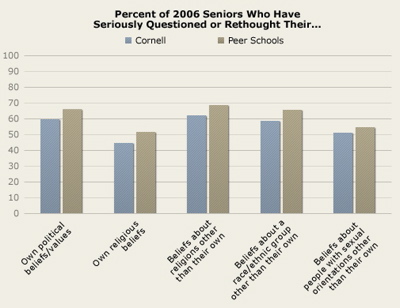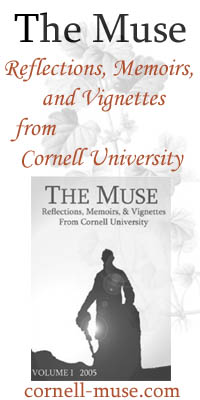Cornell's Open Minds
It's become a common complaint at Cornell that "surface" diversity is more highly valued than intellectual diversity. Paul Ibrahim's recent column on the subject makes a strong case, and the comments posted by readers suggest that more people agree with this view than we tend to think.
Now, finally, there's something to back up this claim, and it comes straight from the horse's mouth to boot:

What does this tell us? That 2006 Cornell seniors are less likely than those at peer schools to have rethought or reconsidered their views in every major category.
This doesn't speak well of Cornell's commitment to "Open Minds" or its commitment to diversity. Context is crucial: This chart is displayed on Cornell's new diversity website, and its chief concern seems to be whether students are thinking hard about their views on diversity -- that of skin color, sexual orientation, etc. Depending on students' preexisting views, these results could be good or bad. But it's interesting that a chart on students' open-mindedness (defined as a willingness to reconsider one's views) is read only as a means to an end -- that of acceptance of all forms of surface diversity.
The lede is being buried in plain sight: Cornell students are not as prone to changing -- or even considering -- their own views, as their peers. Why? There are a million possible reasons. Maybe Cornell students are more vocationally oriented than their peers -- pursuing degrees in hotel management, engineering, or agriculture and caring less about a liberal arts education. Maybe Cornell students are more radical, or more polarized, to begin with. Maybe they're not encouraged to think about other points of view in class. (Credit to Jim S. for help brainstorming here.)
Or maybe, students just don't come into contact with that many people who are different from them. With hundreds of student groups, enclaves, customized housing arrangements, and clubs, it's possible to go through four years of college without leaving your comfort zone or challenging your preconceptions. Cornell's administration encourages this to some degree, all in the name of diversity. But of course, depending on the type of diversity being promoted, this may or may not make sense.
I tend to think that Cornell's diversity rhetoric encourages people to learn less about other cultures, religions or points of view. If every culture and every person is equally valid, and differences are to be worshipped for their own sake, then why bother trying to comprehend a different culture when you can just "appreciate" it from a distance? If we value everyone by default, we learn nothing.
So what do the data say about possible causes? It's hard to tell anything except basic trends. For one thing, Cornell seems to have slightly more students at the extremes of the political spectrum than its peers, at least at the outset. We can attempt to track this over time. The latter conclusion is from the 2004 Freshman Survey, but we can't yet follow that up by looking at those freshmen as seniors, and anyway, the Senior Survey doesn't cover political views. But we can take the 2002 Freshman Survey and see how the class is doing by its junior year in the 2005 Enrolled Student Survey.
First off, in 2002 the freshman class was less extreme than its peers, in contrast with the freshmen two years later. 3.1 percent classified themselves as far left, 1.1 percent far right, and the vast majority in the middle or left (41.8 and 39.8 percent, respectively). Three years later, this same class, now juniors, looks mostly the same, but the far left and liberal groups have gained at the moderates' expense (5.3 and 43.4 percent); the far-right contingent is virtually the same size. Interestingly, the proportion of conservatives also increased, from 14.3 to 16.9 percent, also apparent converts from middle-of-the-roadism. (I repeated this by similarly following freshmen in 2000 through their 2003 responses -- same pattern.)
Facebook also has some rough numbers to offer, although they're a snapshot (as opposed to my jerry-rigged longitudinal look above), it's a much larger sample size (i.e., those who don't leave political preferences blank and do allow their profiles to be searched), and people's political preferences may be colored by the fact that they're viewable by other members. According to our online social fabric, 8.8 percent of the Class of 2006 (that is, the same freshmen in question but after graduating) are "very liberal," 41 percent liberal, 23.3 in the middle, 10.8 conservative and 1.2 very conservative. I'll also throw in the measly 3.2 percent of us who chose to put "Libertarian."
So what do we learn? To the extent that people reconsider their views, they're more likely to move leftward than rightward, although not by much. Movements leftward go further to the extreme than movements rightward. Cornell students become significantly less moderate over time, or perhaps they're gaining conviction. Finally, those on the far right don't seem to budge at all (unless they're becoming even more conservative). Overall, though, most people stay put.
Now this begs the question: How many of those on the far left will turn into the next David Horowitz 10 years from now?



